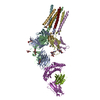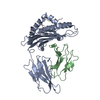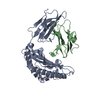[English] 日本語
 Yorodumi
Yorodumi- PDB-8es8: CryoEM structure of PN45545 TCR-CD3 in complex with HLA-A2 MAGEA4... -
+ Open data
Open data
- Basic information
Basic information
| Entry | Database: PDB / ID: 8es8 | ||||||
|---|---|---|---|---|---|---|---|
| Title | CryoEM structure of PN45545 TCR-CD3 in complex with HLA-A2 MAGEA4 (230-239) | ||||||
 Components Components |
| ||||||
 Keywords Keywords |  IMMUNE SYSTEM / TCR / IMMUNE SYSTEM / TCR /  membrane protein / CD3 / HLA / MHC membrane protein / CD3 / HLA / MHC | ||||||
| Function / homology |  Function and homology information Function and homology informationregulation of lymphocyte apoptotic process / gamma-delta T cell receptor complex /  Fc-gamma receptor III complex / T cell anergy / positive regulation of T cell anergy / positive regulation of cell-cell adhesion mediated by integrin / Fc-gamma receptor signaling pathway / CD4-positive, alpha-beta T cell proliferation / gamma-delta T cell activation / negative thymic T cell selection ...regulation of lymphocyte apoptotic process / gamma-delta T cell receptor complex / Fc-gamma receptor III complex / T cell anergy / positive regulation of T cell anergy / positive regulation of cell-cell adhesion mediated by integrin / Fc-gamma receptor signaling pathway / CD4-positive, alpha-beta T cell proliferation / gamma-delta T cell activation / negative thymic T cell selection ...regulation of lymphocyte apoptotic process / gamma-delta T cell receptor complex /  Fc-gamma receptor III complex / T cell anergy / positive regulation of T cell anergy / positive regulation of cell-cell adhesion mediated by integrin / Fc-gamma receptor signaling pathway / CD4-positive, alpha-beta T cell proliferation / gamma-delta T cell activation / negative thymic T cell selection / positive regulation of CD4-positive, alpha-beta T cell proliferation / positive regulation of protein localization to cell surface / alpha-beta T cell receptor complex / positive thymic T cell selection / signal complex assembly / Nef and signal transduction / positive regulation of cell-matrix adhesion / Fc-gamma receptor III complex / T cell anergy / positive regulation of T cell anergy / positive regulation of cell-cell adhesion mediated by integrin / Fc-gamma receptor signaling pathway / CD4-positive, alpha-beta T cell proliferation / gamma-delta T cell activation / negative thymic T cell selection / positive regulation of CD4-positive, alpha-beta T cell proliferation / positive regulation of protein localization to cell surface / alpha-beta T cell receptor complex / positive thymic T cell selection / signal complex assembly / Nef and signal transduction / positive regulation of cell-matrix adhesion /  T cell receptor complex / smoothened signaling pathway / establishment or maintenance of cell polarity / dendrite development / Translocation of ZAP-70 to Immunological synapse / Phosphorylation of CD3 and TCR zeta chains / alpha-beta T cell activation / Generation of second messenger molecules / T cell receptor complex / smoothened signaling pathway / establishment or maintenance of cell polarity / dendrite development / Translocation of ZAP-70 to Immunological synapse / Phosphorylation of CD3 and TCR zeta chains / alpha-beta T cell activation / Generation of second messenger molecules /  immunological synapse / FCGR activation / antigen processing and presentation / PD-1 signaling / positive regulation of interleukin-4 production / Role of phospholipids in phagocytosis / negative regulation of smoothened signaling pathway / positive regulation of cell cycle / positive regulation of calcium-mediated signaling / positive regulation of T cell proliferation / immunological synapse / FCGR activation / antigen processing and presentation / PD-1 signaling / positive regulation of interleukin-4 production / Role of phospholipids in phagocytosis / negative regulation of smoothened signaling pathway / positive regulation of cell cycle / positive regulation of calcium-mediated signaling / positive regulation of T cell proliferation /  protein tyrosine kinase binding / T cell costimulation / positive regulation of interleukin-2 production / cerebellum development / protein tyrosine kinase binding / T cell costimulation / positive regulation of interleukin-2 production / cerebellum development /  T cell receptor binding / T cell receptor binding /  T cell activation / FCGR3A-mediated IL10 synthesis / positive regulation of ferrous iron binding / positive regulation of transferrin receptor binding / positive regulation of receptor binding / early endosome lumen / Nef mediated downregulation of MHC class I complex cell surface expression / DAP12 interactions / negative regulation of receptor binding / calcium-mediated signaling / apoptotic signaling pathway / lumenal side of endoplasmic reticulum membrane / Endosomal/Vacuolar pathway / Antigen Presentation: Folding, assembly and peptide loading of class I MHC / FCGR3A-mediated phagocytosis / clathrin-coated endocytic vesicle membrane / antigen processing and presentation of exogenous protein antigen via MHC class Ib, TAP-dependent / cellular response to iron(III) ion / negative regulation of forebrain neuron differentiation / ER to Golgi transport vesicle membrane / peptide antigen assembly with MHC class I protein complex / response to molecule of bacterial origin / T cell activation / FCGR3A-mediated IL10 synthesis / positive regulation of ferrous iron binding / positive regulation of transferrin receptor binding / positive regulation of receptor binding / early endosome lumen / Nef mediated downregulation of MHC class I complex cell surface expression / DAP12 interactions / negative regulation of receptor binding / calcium-mediated signaling / apoptotic signaling pathway / lumenal side of endoplasmic reticulum membrane / Endosomal/Vacuolar pathway / Antigen Presentation: Folding, assembly and peptide loading of class I MHC / FCGR3A-mediated phagocytosis / clathrin-coated endocytic vesicle membrane / antigen processing and presentation of exogenous protein antigen via MHC class Ib, TAP-dependent / cellular response to iron(III) ion / negative regulation of forebrain neuron differentiation / ER to Golgi transport vesicle membrane / peptide antigen assembly with MHC class I protein complex / response to molecule of bacterial origin /  regulation of erythrocyte differentiation / regulation of iron ion transport / MHC class I peptide loading complex / HFE-transferrin receptor complex / T cell mediated cytotoxicity / cellular response to iron ion / Regulation of actin dynamics for phagocytic cup formation / antigen processing and presentation of endogenous peptide antigen via MHC class I / positive regulation of T cell cytokine production / MHC class I protein complex / regulation of erythrocyte differentiation / regulation of iron ion transport / MHC class I peptide loading complex / HFE-transferrin receptor complex / T cell mediated cytotoxicity / cellular response to iron ion / Regulation of actin dynamics for phagocytic cup formation / antigen processing and presentation of endogenous peptide antigen via MHC class I / positive regulation of T cell cytokine production / MHC class I protein complex /  SH3 domain binding / multicellular organismal-level iron ion homeostasis / positive regulation of T cell mediated cytotoxicity / peptide antigen assembly with MHC class II protein complex / negative regulation of neurogenesis / MHC class II protein complex / positive regulation of receptor-mediated endocytosis / cellular response to nicotine / SH3 domain binding / multicellular organismal-level iron ion homeostasis / positive regulation of T cell mediated cytotoxicity / peptide antigen assembly with MHC class II protein complex / negative regulation of neurogenesis / MHC class II protein complex / positive regulation of receptor-mediated endocytosis / cellular response to nicotine /  histone deacetylase binding / recycling endosome membrane / phagocytic vesicle membrane / specific granule lumen / peptide antigen binding / histone deacetylase binding / recycling endosome membrane / phagocytic vesicle membrane / specific granule lumen / peptide antigen binding /  cell surface receptor protein tyrosine kinase signaling pathway / positive regulation of cellular senescence / antigen processing and presentation of exogenous peptide antigen via MHC class II / Immunoregulatory interactions between a Lymphoid and a non-Lymphoid cell / positive regulation of immune response / negative regulation of epithelial cell proliferation / Interferon gamma signaling / positive regulation of T cell activation / Modulation by Mtb of host immune system / positive regulation of peptidyl-tyrosine phosphorylation / cell-cell junction / signaling receptor complex adaptor activity / positive regulation of type II interferon production / sensory perception of smell / transmembrane signaling receptor activity cell surface receptor protein tyrosine kinase signaling pathway / positive regulation of cellular senescence / antigen processing and presentation of exogenous peptide antigen via MHC class II / Immunoregulatory interactions between a Lymphoid and a non-Lymphoid cell / positive regulation of immune response / negative regulation of epithelial cell proliferation / Interferon gamma signaling / positive regulation of T cell activation / Modulation by Mtb of host immune system / positive regulation of peptidyl-tyrosine phosphorylation / cell-cell junction / signaling receptor complex adaptor activity / positive regulation of type II interferon production / sensory perception of smell / transmembrane signaling receptor activitySimilarity search - Function | ||||||
| Biological species |   Homo sapiens (human) Homo sapiens (human) | ||||||
| Method |  ELECTRON MICROSCOPY / ELECTRON MICROSCOPY /  single particle reconstruction / single particle reconstruction /  cryo EM / Resolution: 2.65 Å cryo EM / Resolution: 2.65 Å | ||||||
 Authors Authors | Saotome, K. / Franklin, M.C. | ||||||
| Funding support | 1items
| ||||||
 Citation Citation |  Journal: Nat Commun / Year: 2023 Journal: Nat Commun / Year: 2023Title: Structural analysis of cancer-relevant TCR-CD3 and peptide-MHC complexes by cryoEM. Authors: Kei Saotome / Drew Dudgeon / Kiersten Colotti / Michael J Moore / Jennifer Jones / Yi Zhou / Ashique Rafique / George D Yancopoulos / Andrew J Murphy / John C Lin / William C Olson / Matthew C Franklin /  Abstract: The recognition of antigenic peptide-MHC (pMHC) molecules by T-cell receptors (TCR) initiates the T-cell mediated immune response. Structural characterization is key for understanding the specificity ...The recognition of antigenic peptide-MHC (pMHC) molecules by T-cell receptors (TCR) initiates the T-cell mediated immune response. Structural characterization is key for understanding the specificity of TCR-pMHC interactions and informing the development of therapeutics. Despite the rapid rise of single particle cryoelectron microscopy (cryoEM), x-ray crystallography has remained the preferred method for structure determination of TCR-pMHC complexes. Here, we report cryoEM structures of two distinct full-length α/β TCR-CD3 complexes bound to their pMHC ligand, the cancer-testis antigen HLA-A2/MAGEA4 (230-239). We also determined cryoEM structures of pMHCs containing MAGEA4 (230-239) peptide and the closely related MAGEA8 (232-241) peptide in the absence of TCR, which provided a structural explanation for the MAGEA4 preference displayed by the TCRs. These findings provide insights into the TCR recognition of a clinically relevant cancer antigen and demonstrate the utility of cryoEM for high-resolution structural analysis of TCR-pMHC interactions. | ||||||
| History |
|
- Structure visualization
Structure visualization
| Structure viewer | Molecule:  Molmil Molmil Jmol/JSmol Jmol/JSmol |
|---|
- Downloads & links
Downloads & links
- Download
Download
| PDBx/mmCIF format |  8es8.cif.gz 8es8.cif.gz | 298.5 KB | Display |  PDBx/mmCIF format PDBx/mmCIF format |
|---|---|---|---|---|
| PDB format |  pdb8es8.ent.gz pdb8es8.ent.gz | 225.4 KB | Display |  PDB format PDB format |
| PDBx/mmJSON format |  8es8.json.gz 8es8.json.gz | Tree view |  PDBx/mmJSON format PDBx/mmJSON format | |
| Others |  Other downloads Other downloads |
-Validation report
| Arichive directory |  https://data.pdbj.org/pub/pdb/validation_reports/es/8es8 https://data.pdbj.org/pub/pdb/validation_reports/es/8es8 ftp://data.pdbj.org/pub/pdb/validation_reports/es/8es8 ftp://data.pdbj.org/pub/pdb/validation_reports/es/8es8 | HTTPS FTP |
|---|
-Related structure data
| Related structure data |  28571MC  8es7C  8es9C  8esaC  8esbC M: map data used to model this data C: citing same article ( |
|---|---|
| Similar structure data | Similarity search - Function & homology  F&H Search F&H Search |
- Links
Links
- Assembly
Assembly
| Deposited unit | 
|
|---|---|
| 1 |
|
- Components
Components
-T-cell surface glycoprotein CD3 ... , 4 types, 6 molecules ZYDFEG
| #1: Protein |  / T-cell receptor T3 zeta chain / T-cell receptor T3 zeta chainMass: 19654.486 Da / Num. of mol.: 2 Source method: isolated from a genetically manipulated source Source: (gene. exp.)   Homo sapiens (human) / Gene: CD247, CD3Z, T3Z, TCRZ / Production host: Homo sapiens (human) / Gene: CD247, CD3Z, T3Z, TCRZ / Production host:   Homo sapiens (human) / References: UniProt: P20963 Homo sapiens (human) / References: UniProt: P20963#2: Protein | | Mass: 19150.719 Da / Num. of mol.: 1 Source method: isolated from a genetically manipulated source Source: (gene. exp.)   Homo sapiens (human) / Gene: CD3D, T3D / Production host: Homo sapiens (human) / Gene: CD3D, T3D / Production host:   Homo sapiens (human) / References: UniProt: P04234 Homo sapiens (human) / References: UniProt: P04234#3: Protein | Mass: 23432.459 Da / Num. of mol.: 2 Source method: isolated from a genetically manipulated source Source: (gene. exp.)   Homo sapiens (human) / Gene: CD3E, T3E / Production host: Homo sapiens (human) / Gene: CD3E, T3E / Production host:   Homo sapiens (human) / References: UniProt: P07766 Homo sapiens (human) / References: UniProt: P07766#4: Protein | | Mass: 20694.639 Da / Num. of mol.: 1 Source method: isolated from a genetically manipulated source Source: (gene. exp.)   Homo sapiens (human) / Gene: CD3G, T3G / Production host: Homo sapiens (human) / Gene: CD3G, T3G / Production host:   Homo sapiens (human) / References: UniProt: P09693 Homo sapiens (human) / References: UniProt: P09693 |
|---|
-Protein , 4 types, 4 molecules ABNM
| #5: Protein | Mass: 30737.512 Da / Num. of mol.: 1 Source method: isolated from a genetically manipulated source Source: (gene. exp.)   Homo sapiens (human) / Production host: Homo sapiens (human) / Production host:   Homo sapiens (human) Homo sapiens (human) |
|---|---|
| #6: Protein | Mass: 35891.855 Da / Num. of mol.: 1 Source method: isolated from a genetically manipulated source Source: (gene. exp.)   Homo sapiens (human) / Production host: Homo sapiens (human) / Production host:   Homo sapiens (human) Homo sapiens (human) |
| #7: Protein | Mass: 32082.512 Da / Num. of mol.: 1 Source method: isolated from a genetically manipulated source Source: (gene. exp.)   Homo sapiens (human) / Gene: HLA-A*02:01 / Production host: Homo sapiens (human) / Gene: HLA-A*02:01 / Production host:   Escherichia coli (E. coli) / References: UniProt: Q861F7 Escherichia coli (E. coli) / References: UniProt: Q861F7 |
| #8: Protein |  Beta-2 microglobulin Beta-2 microglobulinMass: 11879.356 Da / Num. of mol.: 1 / Fragment: UNP residues 21-119 Source method: isolated from a genetically manipulated source Source: (gene. exp.)   Homo sapiens (human) / Gene: B2M, CDABP0092, HDCMA22P / Production host: Homo sapiens (human) / Gene: B2M, CDABP0092, HDCMA22P / Production host:   Escherichia coli (E. coli) / References: UniProt: P61769 Escherichia coli (E. coli) / References: UniProt: P61769 |
-Protein/peptide / Non-polymers , 2 types, 2 molecules P

| #12: Chemical | ChemComp-Y01 / |
|---|---|
| #9: Protein/peptide |  / Cancer/testis antigen 1.4 / CT1.4 / MAGE-4 antigen / MAGE-41 antigen / MAGE-X2 antigen / Cancer/testis antigen 1.4 / CT1.4 / MAGE-4 antigen / MAGE-41 antigen / MAGE-X2 antigenMass: 1134.200 Da / Num. of mol.: 1 / Fragment: peptide (UNP residues 230-239) / Source method: obtained synthetically / Source: (synth.)   Homo sapiens (human) / References: UniProt: P43358 Homo sapiens (human) / References: UniProt: P43358 |
-Sugars , 3 types, 11 molecules 
| #10: Polysaccharide | beta-D-mannopyranose-(1-4)-2-acetamido-2-deoxy-beta-D-glucopyranose-(1-4)-2-acetamido-2-deoxy-beta- ...beta-D-mannopyranose-(1-4)-2-acetamido-2-deoxy-beta-D-glucopyranose-(1-4)-2-acetamido-2-deoxy-beta-D-glucopyranose / Mass: 586.542 Da / Num. of mol.: 1 / Mass: 586.542 Da / Num. of mol.: 1Source method: isolated from a genetically manipulated source | ||
|---|---|---|---|
| #11: Polysaccharide | 2-acetamido-2-deoxy-beta-D-glucopyranose-(1-4)-2-acetamido-2-deoxy-beta-D-glucopyranose  / Mass: 424.401 Da / Num. of mol.: 5 / Mass: 424.401 Da / Num. of mol.: 5Source method: isolated from a genetically manipulated source #13: Sugar | ChemComp-NAG /  N-Acetylglucosamine N-Acetylglucosamine |
-Details
| Has ligand of interest | N |
|---|
-Experimental details
-Experiment
| Experiment | Method:  ELECTRON MICROSCOPY ELECTRON MICROSCOPY |
|---|---|
| EM experiment | Aggregation state: PARTICLE / 3D reconstruction method:  single particle reconstruction single particle reconstruction |
- Sample preparation
Sample preparation
| Component | Name: PN45545 TCR-CD3 complex bound to HLA-A2 MAGEA4 (230-239) with anti-Beta-2-microglobulin Fab Type: COMPLEX / Entity ID: #1-#9 / Source: RECOMBINANT |
|---|---|
| Molecular weight | Experimental value: NO |
| Source (natural) | Organism:   Homo sapiens (human) Homo sapiens (human) |
| Source (recombinant) | Organism:   Homo sapiens (human) Homo sapiens (human) |
| Buffer solution | pH: 8 |
| Specimen | Embedding applied: NO / Shadowing applied: NO / Staining applied : NO / Vitrification applied : NO / Vitrification applied : YES : YES |
Vitrification | Cryogen name: ETHANE |
- Electron microscopy imaging
Electron microscopy imaging
| Experimental equipment |  Model: Titan Krios / Image courtesy: FEI Company |
|---|---|
| Microscopy | Model: FEI TITAN KRIOS |
| Electron gun | Electron source : :  FIELD EMISSION GUN / Accelerating voltage: 300 kV / Illumination mode: FLOOD BEAM FIELD EMISSION GUN / Accelerating voltage: 300 kV / Illumination mode: FLOOD BEAM |
| Electron lens | Mode: BRIGHT FIELD Bright-field microscopy / Nominal defocus max: 2400 nm / Nominal defocus min: 1400 nm Bright-field microscopy / Nominal defocus max: 2400 nm / Nominal defocus min: 1400 nm |
| Image recording | Electron dose: 40 e/Å2 / Film or detector model: GATAN K3 BIOQUANTUM (6k x 4k) |
| EM imaging optics | Energyfilter name : GIF Bioquantum / Energyfilter slit width: 20 eV : GIF Bioquantum / Energyfilter slit width: 20 eV |
- Processing
Processing
| Software |
| ||||||||||||||||||||||||
|---|---|---|---|---|---|---|---|---|---|---|---|---|---|---|---|---|---|---|---|---|---|---|---|---|---|
CTF correction | Type: PHASE FLIPPING AND AMPLITUDE CORRECTION | ||||||||||||||||||||||||
3D reconstruction | Resolution: 2.65 Å / Resolution method: FSC 0.143 CUT-OFF / Num. of particles: 228624 / Symmetry type: POINT | ||||||||||||||||||||||||
| Refinement | Cross valid method: NONE Stereochemistry target values: GeoStd + Monomer Library + CDL v1.2 | ||||||||||||||||||||||||
| Displacement parameters | Biso mean: 59.59 Å2 | ||||||||||||||||||||||||
| Refine LS restraints |
|
 Movie
Movie Controller
Controller






 PDBj
PDBj

















